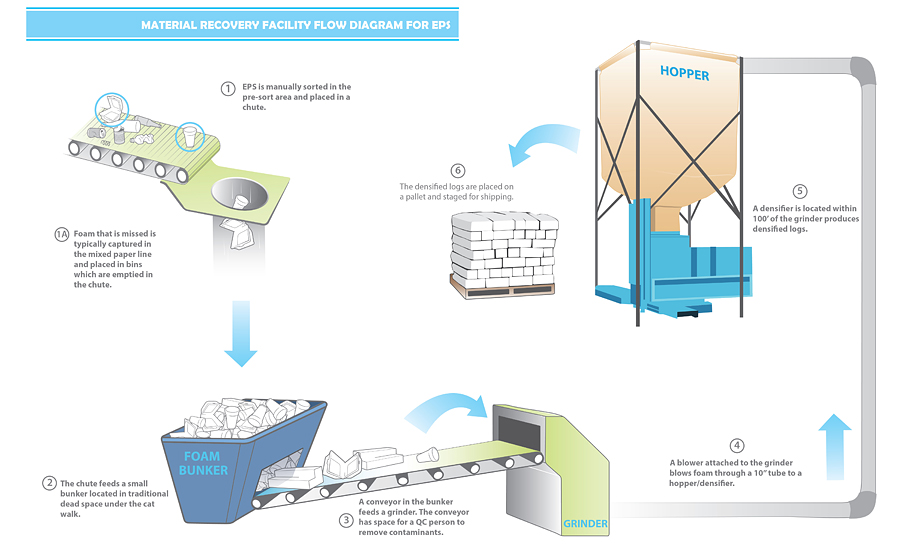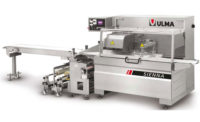While the idea of sustainability has moved past the novelty phase, the need to continue to look for meaningful ways to further reduce the constant stream of waste sent to landfills remains. That’s why the Foodservice Packaging Institute (FPI), Falls Church, Va., launched a new initiative that takes an important step in ensuring valuable reusable materials are recycled instead of sent to landfills.
In 2014, a dozen members of the FPI came together to establish the Foam Recycling Coalition (FRC) to provide direct support for the increased recycling of foodservice packaging made from expanded polystyrene (EPS) foam. Foodservice industry items made of EPS foam include cups, plates, bowls and carryout containers. However, when considering items like the meat packaging and egg cartons from the grocery store often made from the same polystyrene foam, it is just as important to recycle these materials as it is to recycle plastic bottles. With this in mind, in 2015, the FRC, in association with the EPS Industry Alliance (EPS-IA), announced a new grant program to help businesses in the recycling industry increase their capacity to accept post-consumer EPS foam products.
Up until recently, the bulk of EPS foam recycling efforts have focused on industrial sectors where things like protective packaging for refrigerators or televisions result in large volumes of material collected from commercial product distributors and vendors. The FRC grants will target supporting entities that manage residential curbside and drop-off recycling programs to extend foam product recycling to the individual consumer level.
“The idea behind the grant program is to help material recovery facilities recycle EPS cost-effectively,” says Lynn Dyer, president of FPI. “Essentially it’s all about volume and economics. What can we do to make diverting consumer-level EPS foam products from the waste stream more appealing to the recycling industry from an economic perspective?”
The obstacle has always been the sheer volume of space required to transport the recycled foam content to a processor who will then recompose the foam into a reusable form for the next stage of a continued lifecycle. The grant program specifically provides funding for material recovery facilities to purchase a specialized compactor known as a densifier that compresses the foam. Since foam products are more than 90% air, the densifier greatly reduces the volume of space required to store or transport. As an example, a 48-foot truckload of baled EPS foam weighs approximately 16,000 pounds. After the foam is densified, the same truck can be packed with approximately 40,000 pounds of foam, greatly increasing the cost-effectiveness of collecting and redistributing EPS materials.
By supporting post-consumer recycling at the material recovery facility level, the FRC expects to significantly increase the amount of EPS that is returned to the manufacturing process, ultimately getting re-used to manufacture all kinds of products. Currently, EPS foam manufacturers are generally recycling scrap foam in a closed-loop process, meaning the excess foam produced stays in the manufacturing facility and is re-composed with no waste. For those in the EPS industry, regardless of what their foam is manufactured into, increasing recycling opportunities and the public’s awareness of them is important.
“We’re very interested in helping to inform the public that these products can and should be recycled,” says Mary Burk, corporate marketing with ACH Foam Technologies, Westminster, Colo. “Increasing the volume of reusable foam on the consumer level is good for the environment, good for the public and good for the many different industries that use new and recycled EPS foam for everything from commercial insulation for construction to protective packaging for refrigerated foods.”
A common misconception about recycling food packaging products is that foam can’t be recycled at all, which is obviously not the case. The second misconception relates directly to the foodservice industry, where many consumers are under the impression that polystyrene foam packaging used to hold food products is more contaminated than other forms of packaging.
“It’s a continual process with dual objectives of creating opportunities to expand EPS foam recycling opportunities on the individual level and then increase public awareness that those opportunities exist,” adds Dyer.
When the FPI announced the grant program, it was inundated with applications from material recovery facilities across the United States and Canada. FPI applied very specific criteria in selecting the first grant recipient, which involved the company’s current level of innovation, their market reach within their community and their ability to process a combination of commercial, industrial and residential foam products. After an exhaustive review and evaluation, the FRC selected Alpine Waste & Recycling, a Denver, Colo.-based company that has maintained a dedication to sustainable practices since the company’s inception in 1999.
“Alpine has a reputation in this market as the innovators of the waste and recycling industry, while maximizing sustainability and helping to preserve the environment,” says Brent Hildebrand, Alpine Waste’s vice president of recycling. “The grant from the FRC affirms our place as leaders in the recycling community, and we’re very excited to promote this new efficiency in EPS foam recycling with the advanced technology in our expanded, re-tooled recycling plant.”
When asked what is on the horizon for the FRC and their efforts to support EPS foam recycling, the answer is, hopefully more of the same. More grant applicants, more detailed investigations into each applicants’ reach and effectiveness and more grant awards followed by a public information process to make consumers aware of the opportunity to recycle products that are every bit as common and reusable as those made of other materials.



